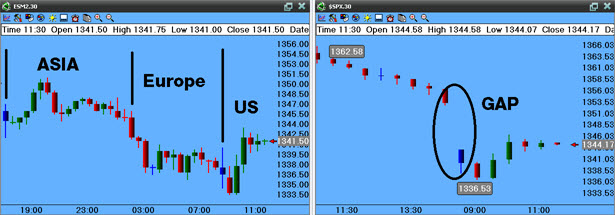Most people who pay attention to the financial markets realize that what happens in Asia and Europe may affect the US market. How many times have you woken up in the morning to hear CNBC or Bloomberg telling you that the European markets are down 2%, that futures are pointing to a lower open, and that markets are below fair value? In a global economy, what happens overseas may drive markets. This may be part of what causes the S&P 500, Dow 30, and NASDAQ 100 indexes to gap up or down when US markets open.
The indexes are a current (live) representation of the stocks that are in them. The indexes show the current value of the index only during the NYSE trading hours (09:30–16:00 ET). This means that during a 24-hour day, the indexes are trading for 6½ hours of the day, or 27% of the time. That leaves 73% of the time that the markets in the US are not representing what is happening around the world. This time gap is what causes our markets in the US to gap up or gap down at the open because our stocks have been traded at the exchanges around the world and have been pushed up or down during overseas markets. The indexes in the US "don’t see" that movement until the markets open in New York. An indicator that tracks the markets 24 hours a day is needed. This is where the futures markets come in.
The index futures are a derivative of the actual indexes. Futures look into the future to "lock in" a future price or try to predict where something will be in the future; hence the name. Since there are futures on the indexes (S&P 500, Dow 30, NASDAQ 100, Russell 2000) that trade virtually 24 hours a day, we can watch the index futures to get a feel for market direction. The futures will move based on the section of the world that is open at that time, so the 24-hour market must be divided into time segments to understand which time zone and geographic region is having the largest impact on the market at any point in time.
The global cycle
The first markets to open are the Asian markets (including Australia and New Zealand), which trade between 18:00–03:00 ET. Europe opens at 03:00 and trades until 09:30 ET. Since the S&P 500, Dow 30, and NASDAQ 100 "belong" to the US, the US takes over at 09:30. However, Europe is still open and trading for the first 2 hours of the US market; so during the morning session of the US markets there is still European influence. As the US markets close, a new day is starting over in Asia. And the cycle begins anew.
Exhibit 1 shows 30-minute charts of the S&P 500 futures (left) and the S&P 500 index (right). The Asian, European, and US markets are on the chart on the left. The futures opened and started trading higher in Asia, then began to weaken. Europe then opened and pulled the market down. The US then opened and began to retrace as Europe closed. Notice the gap in the chart on the right. Since that index is not calculating throughout the night, it ended the previous day, and gapped down since it did not track during the 83% of the time while it was turned off.
Exhibit 1

S&P 500 Futures S&P 500 Index
Before the US market opened, it was known that Europe was weak and that the US would begin at lower prices. Notice the futures have no gap, and the S&P 500 index does. This is what is referred to as a "gap down" at the open, yet there really was no gap based on how the futures traded. So in this case, did futures lead the S&P 500 index down? Not really. If the S&P 500 index was calculating throughout the night, you would see the same pattern. Some would say that the cash (stock) was down to "reconcile" it back to the futures. Again, no, because the stock had already traded lower in the European markets.
Foreign companies (stocks) traded on local exchanges. For example, a New York-based trader can buy Toyota Motor Corp (
In conclusion
You don't have to trade futures to understand what the markets are doing globally. Global markets move on news and it can be seen in the advancement or the decline in the index futures as stocks trade around the world. For information on what the market will do when it opens at 09:30 ET, the index futures are one indicator that offers important information as we approach that open. The market may never sleep, but you don't have to stay up all night wondering where stocks might be when you get out of bed. Just look at the index futures.


